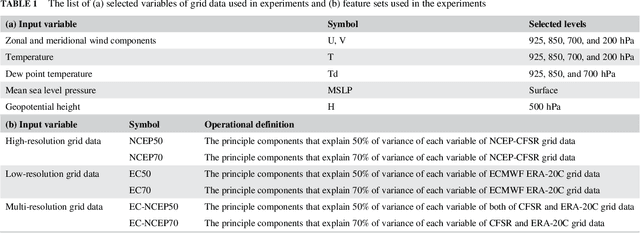Shih-Hao Su
Learning Representations of Satellite Images with Evaluations on Synoptic Weather Events
Aug 08, 2025Abstract:This study applied representation learning algorithms to satellite images and evaluated the learned latent spaces with classifications of various weather events. The algorithms investigated include the classical linear transformation, i.e., principal component analysis (PCA), state-of-the-art deep learning method, i.e., convolutional autoencoder (CAE), and a residual network pre-trained with large image datasets (PT). The experiment results indicated that the latent space learned by CAE consistently showed higher threat scores for all classification tasks. The classifications with PCA yielded high hit rates but also high false-alarm rates. In addition, the PT performed exceptionally well at recognizing tropical cyclones but was inferior in other tasks. Further experiments suggested that representations learned from higher-resolution datasets are superior in all classification tasks for deep-learning algorithms, i.e., CAE and PT. We also found that smaller latent space sizes had minor impact on the classification task's hit rate. Still, a latent space dimension smaller than 128 caused a significantly higher false alarm rate. Though the CAE can learn latent spaces effectively and efficiently, the interpretation of the learned representation lacks direct connections to physical attributions. Therefore, developing a physics-informed version of CAE can be a promising outlook for the current work.
A Deep Learning Approach to Radar-based QPE
Feb 15, 2024Abstract:In this study, we propose a volume-to-point framework for quantitative precipitation estimation (QPE) based on the Quantitative Precipitation Estimation and Segregation Using Multiple Sensor (QPESUMS) Mosaic Radar data set. With a data volume consisting of the time series of gridded radar reflectivities over the Taiwan area, we used machine learning algorithms to establish a statistical model for QPE in weather stations. The model extracts spatial and temporal features from the input data volume and then associates these features with the location-specific precipitations. In contrast to QPE methods based on the Z-R relation, we leverage the machine learning algorithms to automatically detect the evolution and movement of weather systems and associate these patterns to a location with specific topographic attributes. Specifically, we evaluated this framework with the hourly precipitation data of 45 weather stations in Taipei during 2013-2016. In comparison to the operational QPE scheme used by the Central Weather Bureau, the volume-to-point framework performed comparably well in general cases and excelled in detecting heavy-rainfall events. By using the current results as the reference benchmark, the proposed method can integrate the heterogeneous data sources and potentially improve the forecast in extreme precipitation scenarios.
* 22 pages, 11 figures. Published in Earth and Space Science
Identification of synoptic weather types over Taiwan area with multiple classifiers
May 21, 2019



Abstract:In this study, a novel machine learning approach was used to classify three types of synoptic weather events in Taiwan area from 2001 to 2010. We used reanalysis data with three machine learning algorithms to recognize weather systems and evaluated their performance. Overall, the classifiers successfully identified 52-83% of weather events (hit rate), which is higher than the performance of traditional objective methods. The results showed that the machine learning approach gave low false alarm rate in general, while the support vector machine (SVM) with more principal components of reanalysis data had higher hit rate on all tested weather events. The sensitivity tests of grid data resolution indicated that the differences between the high- and low-resolution datasets are limited, which implied that the proposed method can achieve reasonable performance in weather forecasting with minimal resources. By identifying daily weather systems in historical reanalysis data, this method can be used to study long-term weather changes, to monitor climatological-scale variations, and to provide a better estimate of climate projections. Furthermore, this method can also serve as an alternative to model output statistics and potentially be used for synoptic weather forecasting.
* journal article, open access
 Add to Chrome
Add to Chrome Add to Firefox
Add to Firefox Add to Edge
Add to Edge